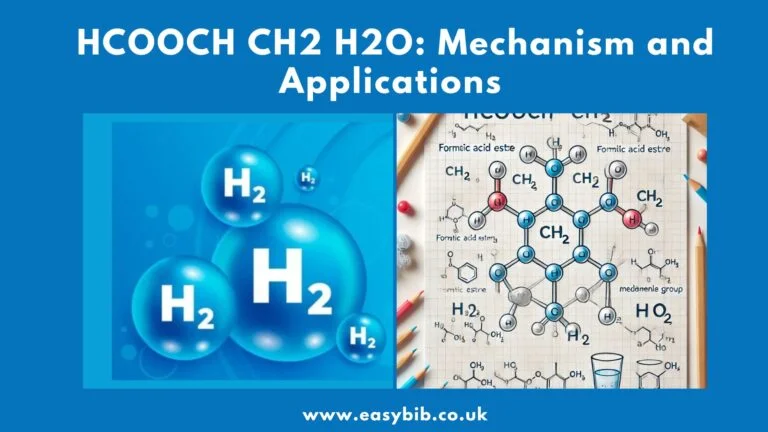In the realm of organic chemistry, complex reactions involving esters, alcohols, and water are essential to understanding the behavior and transformation of compounds in both laboratory and industrial settings. The equation involving methyl formate (HCOOCH₃), methanol (CH₃OH), and water (H₂O) presents a valuable case for analyzing ester hydrolysis and equilibrium processes in chemical systems.
Chemical Overview of the Compounds
Methyl Formate (HCOOCH₃)
Methyl formate is the simplest formate ester, composed of formic acid (HCOOH) and methanol (CH₃OH). It is a colorless, volatile liquid with a characteristic odor, often used in solvents, chemical synthesis, and as an intermediate in producing other organic compounds.
Methanol (CH₃OH)
Methanol is a simple alcohol, often referred to as wood alcohol. It is widely used as a solvent, antifreeze, fuel, and feedstock in chemical manufacturing.
Water (H₂O)
Water acts as a nucleophile in many chemical reactions. In the presence of esters, it plays a pivotal role in hydrolysis, helping to break down esters into their constituent acid and alcohol.
The Core Reaction: Ester Hydrolysis
The combination of HCOOCH₃, CH₃OH, and H₂O often represents a hydrolysis reaction or an equilibrium reaction under acidic or basic conditions, where esters undergo transformation into alcohol and acid.
Balanced Hydrolysis Reaction:
Under acidic or basic conditions:
HCOOCH₃ + H₂O ⇌ HCOOH + CH₃OH
This equation describes the acid-catalyzed hydrolysis of methyl formate yielding formic acid (HCOOH) and methanol (CH₃OH). In this scenario, water acts as the nucleophile, attacking the carbonyl carbon of the ester and cleaving the ester bond.
Reaction Mechanism: Acid-Catalyzed Ester Hydrolysis
Step 1: Protonation of the Ester Carbonyl
The ester’s carbonyl oxygen is protonated by an acid, increasing the electrophilicity of the carbonyl carbon.
Step 2: Nucleophilic Attack by Water
Water attacks the carbonyl carbon, forming a tetrahedral intermediate.
Step 3: Proton Transfers
Several proton transfers rearrange the molecule and stabilize leaving groups.
Step 4: Departure of the Alcohol
The methanol group (CH₃OH) leaves, resulting in the formation of formic acid.
Role of Equilibrium in the Reaction
The hydrolysis of methyl formate is reversible, meaning it can also proceed in the esterification direction:
HCOOH + CH₃OH ⇌ HCOOCH₃ + H₂O
This equilibrium highlights the delicate balance between esterification and hydrolysis, influenced by factors like:
Concentration of reactants
Temperature
Catalyst presence (acid/base)
Removal or addition of water
Thermodynamics and Kinetics
1. Enthalpy and Free Energy
The hydrolysis of esters is generally exothermic, releasing heat.
The spontaneity depends on Gibbs free energy (ΔG), which can be influenced by concentration and temperature.
2. Reaction Rate
Catalyzed hydrolysis proceeds faster than uncatalyzed.
Strong acids like H₂SO₄ or strong bases like NaOH can dramatically accelerate the reaction.
Industrial and Laboratory Applications
1. Organic Synthesis
This reaction is widely used in labs for:
Producing formic acid for chemical manufacturing
Synthesizing alcohols and esters as intermediates
Demonstrating equilibrium and Le Châtelier’s principle in chemistry education
2. Pharmaceutical and Fragrance Industries
Esters like methyl formate are used in:
Perfume formulations
Flavorings
Solvents for drug synthesis
Hydrolysis reactions help tailor solubility and stability of pharmaceutical compounds.
Environmental and Safety Considerations
Toxicity
Methyl formate is flammable and moderately toxic when inhaled in large amounts.
Proper ventilation, PPE (Personal Protective Equipment), and handling protocols are essential.
Biodegradability
Esters typically break down in nature via microbial action.
The products, methanol and formic acid, are biodegradable and less harmful in diluted forms.
Reaction Optimization in Laboratories
Chemists optimize ester hydrolysis by:
Adjusting pH: Acid or base catalysis speeds up reaction
Controlling temperature: Elevated temperatures accelerate kinetics
Manipulating concentrations: Using excess water drives hydrolysis forward
Using distillation: Removing methanol or water as it forms shifts equilibrium toward completion
Mathematical Modeling of the Reaction
The kinetics can be modeled using pseudo-first-order kinetics when water is in excess. The rate law is given by:
Rate = k[HCOOCH₃]
Where:
k is the rate constant
[HCOOCH₃] is the concentration of methyl formate
Advanced computational models also simulate transition states and intermediates using quantum chemistry.
Future Research and Applications
The hydrolysis and synthesis of esters like methyl formate are evolving with:
Green chemistry initiatives: Using bio-catalysts and solvent-free systems
Renewable feedstocks: Biomass-derived methanol for sustainable ester production
Microreactor technologies: Enhancing efficiency and control of ester reactions in continuous flow systems
Conclusion
The chemical interplay between methyl formate (HCOOCH₃), methanol (CH₃OH), and water (H₂O) presents a fundamental insight into ester hydrolysis and equilibrium chemistry. Whether used in educational demonstrations or large-scale industrial synthesis, the reaction embodies critical concepts in organic chemistry, reaction kinetics, and thermodynamics. Mastery of such processes opens doors to innovative applications in chemical manufacturing, pharmaceuticals, environmental science, and sustainable technologies.





